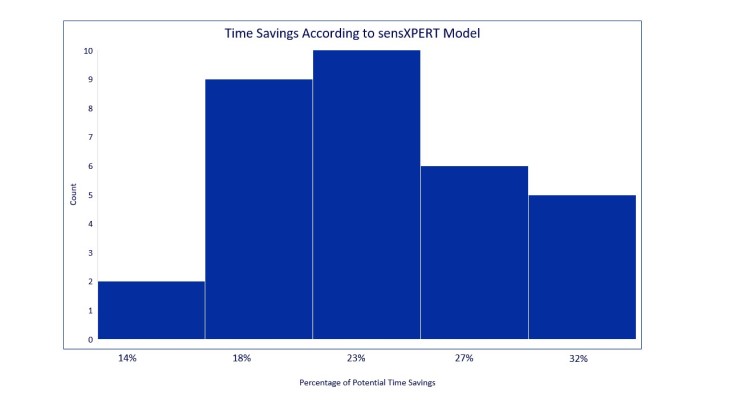The global pumps manufacturing industry has been gradually growing over the past few years. Increasing demand from the power, oil and gas, water, and chemical markets has propelled the development of more efficient pumps and systems that are able to endure and reliably convey various substances; including slurries, liquids, and gases [1]. In 2021, the industrial pumps market was valued at approximately $70 billion and is expected to increase to $90 billion by 2025 [1].

Pumps, specifically industrial pumps, have applications in a variety of industries; water and wastewater, chemical, environment and energy, battery, oil and gas, food and beverage, power generation, and construction to name a few. With a high demand for efficient and robust pumps, manufacturers must ensure that their production processes are optimized and able to contend with competitors.
In their efforts to improve productivity levels and contend with high demands, manufacturers can encounter several challenges that might hinder them in achieving their goals. One such challenge is having long cycle times to ensure sufficient part curing or vulcanization yet having a considerable amount of energy and time lost in the process.
However, implementing process control solutions that provide transparency and allow for dynamic process adaptation is one valuable way of confronting this difficulty. This use case will demonstrate the potential of having material-based dynamic cycle times to increase process efficiency at NETZSCH Pumps & Systems with sensXPERT Digital Mold integrated in their manufacturing.
NETZSCH Pumps & Systems:
With applications in the above-mentioned industries, NETZSCH Pumps & Systems has been manufacturing and distributing a wide range of pump solutions for over 70 years. From multi screw pumps to rotary lobe pumps, NETZSCH Pumps & Systems has a variety of solutions for every application area.
In the case at hand, NETZSCH Pumps & Systems collaborated with sensXPERT to determine and enact optimization opportunities in one of their elastomer manufacturing processes. The specific pump manufacturing process under examination was that of the NEMO® progressing cavity pump.
What are progressing cavity pumps?
Progressing cavity pumps are positive displacement pumps, meaning that force is applied to the entrapped contents of the pump and mechanically moves it forward through the system. The pump is designed in such a way as to avoid the contents recirculating back. Most commonly used in heavy duty industries, the progressing cavity pump can withstand media – such as slurries and sludge – that are abrasive and highly viscous. Additionally, this type of pump is capable of handling shear-sensitive materials.
“The main components are a rotating rotor and a stationary [rubber] stator. The rotor, hinged or elastically attached on one side, is a round-threaded screw. On the output side, the axial position oscillates. The hollow stator is elastic and has the same pitch length as the rotor. This leaves conveying spaces between the stator and the rotor, which move continuously from the inlet to the outlet side. The size of the delivery spaces and the associated delivery rate depends on the size of the construction. Except for the rotor and stator, all other components are identical.” [2]
Overall, to keep up with market demands, pump manufacturers have to ensure that their production processes are optimized. With that in mind, the collaboration between sensXPERT and NETZSCH Pumps & Systems uncovered the significant potential for timesaving through cycle time reduction.
Manufacturing Progressing Cavity Pump Rubber Stators:
Before delving into the collaboration, it is worth considering the progressing cavity pump production process at NETZSCH Pumps & Systems.
While the progressing cavity pump is, as previously mentioned, comprised of a rotating rotor and rubber stator, our focus is on the production of the rubber stator.
To begin with, thin sheets of synthetic rubber are drawn into the molding machine. The rubber injection molding process commences, the drawn material is plasticized in a screw, and is then injected into the mold. After injection into a heated mold, the material vulcanizes, and the stator is formed. The stator is produced with the geometry of the rotor in mind, so that there is enough space to form the cavities that contain various mediums during pumping.
Each machine can be equipped with various mold cavities, as they are separated from one another and can be exchanged. NETZSCH Pumps & Systems produces stators of various lengths and diameters, thus, depending on the geometry of the stator, some molds might have differing numbers of cavities. Additionally, process parameters vary per geometry.
During production, to reach a desired degree of vulcanization of 90%, safety margins were implemented by prolonging the cycle time. These safety margins ensure sufficient vulcanization and see to it that the part will work reliably for its entire lifecycle.
Degree of vulcanization refers to the number of crosslinks that have formed between the molecules in the rubber material, relative to the potential crosslinks that could form.
Measuring the degree of vulcanization is not a simple task, especially in production. Today, mechanical rubber process analyzers – resembling large rheometers – are used to calculate the degree of vulcanization via the torque, which increases during curing. Additional measurements are performed through differential scanning calorimetry (DSC), which is a standard instrument used to determine the reaction heat enthalpy, as well as to calculate curing accordingly. Since rubber is a highly filled polymer, with a very low amount of active substance, DSC results are often not very reproducible and significant in comparison to the investigation of neat polymers.
Following the completion of a production cycle, the mold cools down and the part is ejected.
While this process proves successful in its ability to produce acceptable, well-performing parts, an opportunity for optimization presented itself in the cycle times. In light of this, NETZSCH Pumps & Systems began their collaboration with sensXPERT in 2021.
The sensXPERT x NETZSCH Pumps & Systems Collaboration:
With the primary goal of cutting down cycle times, the sensXPERT Digital Mold solution was integrated into the rubber stator production process. Besides cycle time reduction, sensXPERT is a solution that generates insight into in-mold material characterization data and predicts process outcomes. With a combination of advanced measuring hardware and material science with artificial intelligence, this solution can accurately forecast the influence of internal and external mold conditions on final part quality and performance.
Four components – specifically, material characterization (dielectric) sensors, an Edge Device, the WebApp, and the Digital Cloud Service – are integrated into production processes.
Using dielectric analysis, the material characterization sensors measure and track in-mold material behavior. From thermosets and thermoplastics to elastomers and fiber-reinforced polymers, these sensors are capable of measuring a wide range of materials. All sensor data is transmitted to the sensXPERT Edge Device, which is adept at scanning all incoming data, using machine learning algorithms to detect patterns, and forecasting outcomes in each process.
The WebApp is an interface to the Edge Device that visualizes the data and is used as a real-time monitoring display for process operators. Finally, the sensXPERT Digital Cloud Service collects all historical process data and is a key digital tool in the sensXPERT package. Using the Digital Cloud Service, manufacturers can compare data across multiple production sites, enabling them to locate all optimization opportunities.
For the manufacturing process at hand, the sensXPERT sensor placements were thoroughly considered and discussed with NETZSCH Pumps & Systems prior to integration.
Initially, tooling experts examined the stator parts and indicated the positions at which wall thickness was highest. The thermal behavior of a section with higher wall thickness is more complex than sections with lower wall thickness, making the former the most suitable place to position a sensor and measure.
Subsequently, the production process central to this case involved the instrumenting of each molding cavity with one material characterization sensor. Due to the positioning of the cavities, sensXPERT customized the sensor cables to ensure adequate reach.
“We expect the new technology to increase efficiency by significantly reducing cycle times. We are very pleased to be able to support our corporate venture sensXPERT® through this collaboration and to generate added value for ourselves. This AI-based technology perfectly supports our aspiration to further automate and digitize our value chain.”
Jens Heidkötter, Managing Director at NETZSCH Pumps & Systems
Measurements, Validation, & Results:
Finally, with the Edge Device placed outside, but in the vicinity of the molding machine, sensXPERT measurements could ensue.
Using the initial data that was collected via the sensors and Edge Device, sensXPERT data scientists built up a machine learning (ML) model. With the initial ML model, NETZSCH Pumps & Systems and sensXPERT data scientists performed an on-site validation of the model. Instructions were provided to manually stop the molding cycle once the model predicted that a certain degree of vulcanization had been reached. Afterwards, part samples were tested to validate the model’s predictive capabilities. The validation step allowed for further development of the ML model.
Following the validation, a stop trigger was introduced to the process. This ensures that once a cycle reaches the desired degree of vulcanization, according to the predictive model, the edge device will send a trigger to automatically stop the machine and molding cycle.
All in all, the sensXPERT x NETZSCH Pumps & Systems collaboration led to several successful results. The following histogram illustrates the potential time savings that will be attained during vulcanization. The histogram demonstrates how integrating sensXPERT leads to an average savings potential of 23% of the vulcanization time, with minimum and maximum potential savings in extreme cycles being 14% and 32%, respectively.

The sensXPERT solution is expected to save NETZSCH Pumps & Systems around 15% of their rubber stator production cycle time. Therefore, with less time taken to manufacturing these parts, additional advantages will be obtained such as lowered energy expenditures and more time saved for personnel.
“During the curing time, the machine is closed, and no one knows what happens inside on a molecular level. Thus, the process is like a black box. Typically, a fixed heating time is set for a part to get the demanded degree of cure, which should give the part its optimal mechanical properties. However, there are different influences on the material, like variety in batches, mold temperatures and environment. To cope with these influences, the heating time is preventively extended. This is the so- called fear factor.
With help from sensXPERT®, we can now see what happens inside the material when the mold is closed. The solution measures the degree of cure, predicts the process through the collected data and stops heating at the exact point, when the optimal mechanical properties are reached. Thus, sensXPERT® empowers us to produce complex parts at highest quality and save machine time leading to lower production costs and higher output. That’s why we are very excited to be one of the first partners in this area.”
Frank Götz, Process Engineer at NETZSCH Pumps & Systems
Ultimately, sensXPERT Digital Mold generates greater process efficiency in numerous manufacturing environments. The solution combines the powerful Edge Device – with a stop trigger function – the material characterization sensors, and Cloud accessibility to support manufacturers with process automation, transparency, and digitization. Additionally, manufacturers – such as NETSCH Pumps & Systems – can gain access to a digital thread per part produced, observe long-term trends and drifts in the data, as well as identify process optimization opportunities through the sensXPERT Digital Cloud Service.
